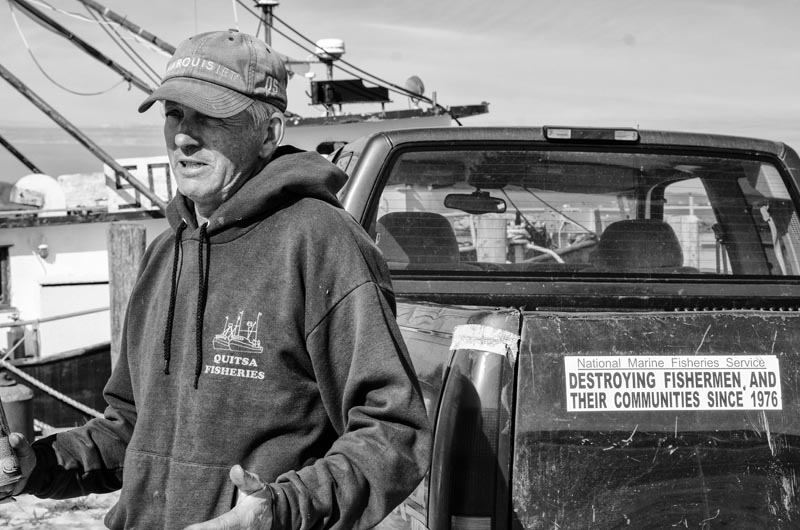The Quitsa Strider II, an iconic fishing dragger that has long been synonymous with the working waterfront in Menemsha, has been sold to a New Bedford dealer.
Matthew Mayhew and his father, Jonathan Mayhew, made their last run on the 72-foot dragger to New Bedford last Friday. From there, it may be sold whole or for scrap. Several parties have already expressed interest, he said.
“Obviously, it’s a bittersweet moment,” the younger Mr. Mayhew said this week. “It’s tough to lose something that is so important and has been such a big part of your life, but at some point in time you have to figure out how to move forward.”
Mr. Mayhew, a 32-year-old fisherman and electrician, said the steel vessel had deteriorated in recent years not because of a lack of available fish, but due instead to limitations imposed on fishing permits.
“The demand is there, the prices are high, but you just aren’t allowed to catch the fish,” he said. The government has cut both the numbers of permits and catch quotas, threatening the livelihood of the small fishermen, Mr. Mayhew said.
The news was all around the Menemsha waterfront this week, where a once-robust fleet of commercial fishing boats has dwindled to a few.
Matthew Mayhew, who became captain of the Strider about six years ago, is a 12th-generation Islander and fourth-generation fisherman. Determined to continue the family fishing tradition, he said he hopes to purchase another vessel to fish in the waters off Menemsha next summer. He and other local fishermen are working to develop a business plan to attract investors interested in preserving the Menemsha fishing tradition.
Jonathan Mayhew bought the Quitsa Strider II in 1990 as successor to the original Quitsa Strider, a 53-foot vessel. For many years, Jonathan and his brother Gregory went out from Menemsha together, searching the waters for squid, swordfish, flounder, scup, fluke and sea bass.
The Quitsa Strider would always be seen docked beside the Unicorn, a vessel that joined the Menemsha fleet in 1984 and remains there today, still captained by Gregory Mayhew.
“It was a good, hard living,” Jonathan said from the Menemsha docks on Thursday, as he reminisced about his former glory days as a swordfish spotter. He flew the plane, and his brother drove the boat. Sometimes they caught 60 to 100 fish per trip, a journey that took 12 to 14 days. Many years, they traveled out to Georges Bank beyond the border with Canada, a veritable swordfish hotspot.
“We had the swordfish fever, as we used to say,” Gregory said.
Back then, there were several multi-species draggers in the harbor — Mary Elizabeth, Aquarius, Mary and Verna, among them.
“Greg and I are sort of the history and Matt and Todd are the future,” Jonathan said, referring to their respective sons. “Although it’s a tough future for small boats.”
In 1995, due to regulations restricting the size of fishing boats, Jonathan Mayhew cut two feet off the bow of the Quitsa. Gregory did the same to the Unicorn.
Quitsa Strider II has been the subject of many photographs and paintings through the years, including Strider’s Surrender, a painting by Heather Neill which was donated to the Martha’s Vineyard Museum in 2008.
“Nobody likes change do they? And that is a big change,” said Menemsha charter boat captain Scott McDowell this week. “It’s too bad.” He remembers the day the Strider entered the harbor in 1990, hard to miss because of its grand size — 75 feet at the time.

“It was a big moment,” he said.
One week ago, the Strider left its home en route to New Bedford. “It just quietly left the harbor,” said Chris Stien, who watched it go. He said he used to fish for lobster on the original Quitsa.
“You always hate to see a change like that, but it was definitely the right time,” Mr. Stien said. “It’s the beginning of another chapter.”
He rejected the notion that the sale of the boat marked a broader decline in the Menemsha fishery.
“Boats get tired,” he said. “It was just the boat’s time.”
The Strider’s sale is just one of a slew of changes on the working waterfront in Menemsha.
The harbor was once chock-full of commercial fishing boats, but these days, high fuel costs, catch limits and the forced specialization of fishermen have diminished the strength of the small fishery, Chilmarkers said this week.
“Lots of people are getting out of the business,” said Scott Maccaferri, a safety inspector with the Coast Guard. Still, he said, the Chilmark harbor acts as a staging area for boats from Fall River and New Bedford, where fishing still means big business.
Mr. Mayhew said limited access to the fishery started with privatization of the public resource. “They made license in the name of keeping the resource around,” he said. Though they intended to protect the fish, the end result benefited the consolidated fishery, the big boats that can afford the high cost of fishing permits.
“The small boats get disenfranchised,” said Jonathan Mayhew.
This year, Gregory Mayhew obtained a permit that allows him to catch only three fish per trip.
With fuel at $3.50 a gallon off-Island and $4.50 on the Vineyard, the trip isn’t financially practical.
Fisherman Preston Butler said that regulations have unfairly punished small fishermen.
“As of right now, you need lots of money to make any money,” Mr. Butler said. “Still, some regulations are necessary because fish can’t protect themselves.”
Before 1976, fishermen didn’t need permits to do their daily work. “They just needed to get a boat and catch fish,” Matthew Mayhew said.
He said he might like to become a scalloper in the future. Still, a full scallop license costs $3 million.
Marshall Carroll, manager of the Texaco fuel station, said as long as the town maintains Menemsha as a commercial fishing harbor, the boats will continue to tie up at Dutcher Dock.
“As long as it stays that way, they will have a home and a place to tap,” Mr. Carroll said.
Still, Jonathan Mayhew said: “It’s hard on the kids, seeing the boat go that they grew up on.”








Comments (5)
Comments
Comment policy »